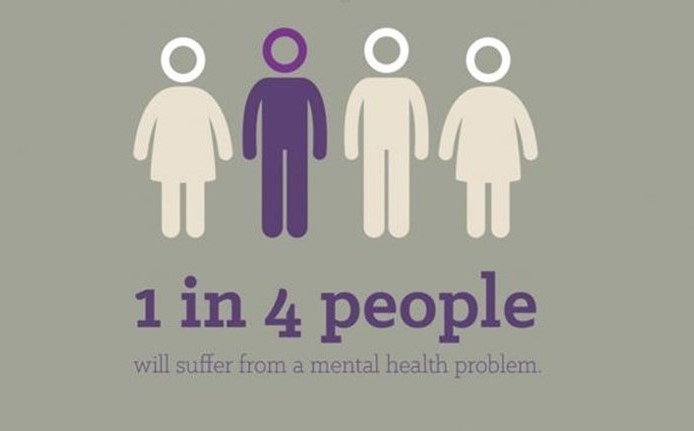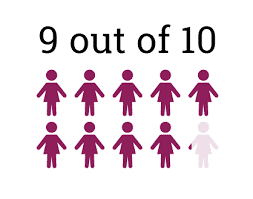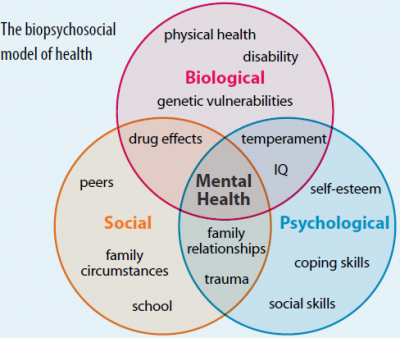Mental Health Awareness - Learners
Introduction to Mental Health
Please take time to watch the video below and read the information provided to help raise your awareness of mental health issues, you may be surprised by what you read!
At the bottom of the page you will find some essential reading material that will help you when answering the Mental Health Awareness quiz. Its important that once you have completed this quiz you update your own CPD records.
Introduction to mental health – Key Facts
 Managers
and
employers
play
a key role in improving the mental health and wellbeing of people in the
workplace.
Managers
and
employers
play
a key role in improving the mental health and wellbeing of people in the
workplace.
This
module aims
to provide you with an understanding of mental health problems so you know how
to support people at work, promote mental health awareness and encourage a
healthy working environment.
Intent of this awareness module
- Understand
what is meant by 'mental health'.
-
Be
aware of the legal responsibilities that employers have in regards to mental
health.
- Understand
some
of the most common mental health problems.
- Understand
ways in which people can manage their individual mental health to make everyday
living easier.
- Be
aware of how to support a colleague with a mental health problem in the
workplace.
-
Understand
how to promote a healthy, non-discriminatory working environment.
-
Have
knowledge of the workplace adjustments that can be made to help an employee
with a mental health problem.
Introduction - What is Mental
health?
'Mental
health'
is defined as 'a person’s condition with regard to their psychological and
emotional wellbeing'. Everybody has mental health in the same way that everyone
has physical health.
Good
mental health is characterised
by a person's ability to cope with everyday life.
Learning and Mental Health

People
with
good mental health are better able to
learn new things, feel emotions, express emotions, form relationships and cope
with change and uncertainty.
What is Mental Health?
- Mental health problems affect the
way a person thinks, feels and behaves and can
have a severe impact on a person's ability to carry out their daily life
- No two people
experience the same symptoms or effects when they are unwell, which often leads
to people making assumptions or unfair judgements about the person.
- The majority of
people can
learn
to live with mental health or
recover if
they
receive the appropriate support.
Mental Health - Statistics
 Around
a quarter of the population experience some kind of mental health problem in
any one year.
Around
a quarter of the population experience some kind of mental health problem in
any one year.
 9
out
of 10 people with mental health problems experience stigma and discrimination.
9
out
of 10 people with mental health problems experience stigma and discrimination.
 Anxiety
and depression are the most common problems, with around 1 in 10 people
affected at any one time.
Anxiety
and depression are the most common problems, with around 1 in 10 people
affected at any one time.
Common causes of Mental Health
issues

Mental
health
problems are often a result of several contributing factors and are not due to
one single cause.
To
help you understand where a person's illness may have originated, consider this
image of the biopsychosocial model of mental health, which shows many of the
factors that commonly contribute towards a mental health problem.
Common symptoms of Mental Health
issues
The
following
list of behaviours
shows some common symptoms that may be displayed by someone experiencing a
mental health problem. However, be careful not to make assumptions, people with
a mental health problem may exhibit none, some or all of the following symptoms:
-
Difficulty
sleeping
- Feeling
sad or being overly tearful
- Low
self-esteem
- Negative
or racing thoughts
- Weight
loss, gain or changes in appetite
- Hallucinating
or hearing voices
- Self-harm.
Suicidal
feelings
- Tiredness.
Headaches
- Loss
of motivation
- Social
withdrawal
The image below represents what mental health issues often look like!!

Stigma around Mental Health
issues
Having
a
mental illness is surrounded by stigma.
Stigma
is
a negative term and is closely linked with prejudice and discrimination against
certain people.
Furthermore,
the fear of stigma can often make the situation worse and cause the person more
stress if they are trying to hide their feelings or avoid talking about their
condition in fear of what other people will think.
 Many
people say that being discriminated against in work and social situations can
be
a bigger burden than the illness itself.
Many
people say that being discriminated against in work and social situations can
be
a bigger burden than the illness itself.
Stigma in the workplace &
Mental Health issues
In
the
workplace, many employers do not fully understand mental health problems,
do not
know how to react to them or what adjustments to the workplace are needed.
Mental
health
illnesses are considered 'invisible' and cannot be seen in the same way that a
physical illness can, there is often a misunderstanding of how serious the
conditions can be.

People wrongly assume that because they cannot
see anything is the matter on the outside, the problem isn't there.
What can you do to help?
 If
a
colleague is unwell with a mental health problem you may be
unsure of what you can do to help, worry that you'll say the wrong thing or be
concerned about how their illness will affect the day-to-day running of your
business. These are all normal reactions to have.
If
a
colleague is unwell with a mental health problem you may be
unsure of what you can do to help, worry that you'll say the wrong thing or be
concerned about how their illness will affect the day-to-day running of your
business. These are all normal reactions to have.
However,
the main thing you can do to help is simply offer your support, even the
smallest of actions can make a huge difference.
- Keep the person involved at work
- Don’t exclude them
- Ask them how they are and offer
support
- Be respectful, open-minded
- Don't pressure them into admitting what's wrong
What to do if you have concerns
for someone?
A – APPROACH
L – LISTEN
G – GIVE SUPPORT
E – ENCOURAGE
PROFESSIONAL ADVICE
E – ENCOURAGE OTHERS
SUPPORT
USEFUL LINKS for suffers and supporters of those with mental
health issues:
Mental Health, the Law and Work

Under
the Equality Act 2010, people with a mental disability are taken just as
seriously as those with a physical disability, and protection is given to them
against discrimination. However,
to get protection under the Equality Act, the mental health problem must be
diagnosed as a disability.
To
be
classified as a disability the person must have had the mental health condition
for at least 12 months and will need to be able to show that they are
experiencing substantial disadvantages at work because of their illness.
Once
the person has been confirmed to have a disability due to their mental health
problem, it then becomes illegal for employers to discriminate against them
because of their health. For example, you could not refuse the person a job
promotion based on the state of their mental wellbeing.
Employers
are also required to make reasonable adjustments to the workplace to help the
person under the Act.
Mental Health, Discrimination
and Work
Many
people who
have a mental health problem are NOT protected
by the Equality Act because their condition has not been deemed a disability.
These
people are often treated differently or worse than others at work because of
their illness, yet this is still discrimination and the person may still have a
legal right to challenge it.
New
provisions
in the Equality Act have made it illegal for employers to ask health or
health-related questions before making a conditional offer of employment to a
candidate. The aim is to prevent employers from making discriminatory decisions
based on a person's current or past mental health.
Risk Assessment
 All
employers have
a legal responsibility under the Health and Safety at Work Act 1974 to
safeguard the health and safety of their employees whilst at work. As part of
this responsibility, employers are required to undertake a risk assessment in
order to identify, control and manage the hazards to health and safety.
This
includes
assessing the risks to employees' mental health as well as their physical
health.
All
employers have
a legal responsibility under the Health and Safety at Work Act 1974 to
safeguard the health and safety of their employees whilst at work. As part of
this responsibility, employers are required to undertake a risk assessment in
order to identify, control and manage the hazards to health and safety.
This
includes
assessing the risks to employees' mental health as well as their physical
health.
To
complete a risk assessment you will need to fulfil each of the following
stages:
-
Identify the risks - look at the tasks, environmental
factors, relationships etc. in the workplace to identify what may cause people
problems.
- Decide who may be harmed and how - consult employees or do
a questionnaire to see how people feel. Some people may be affected more than
others.
- Evaluate the risks and decide on suitable controls - how
can the identified risks be controlled and are there adjustments that can be
made to the workplace or tasks etc. to make things better?
- Record the findings - keep a written record of your
assessment to refer back to and to show your compliance with health and safety
law.
- Monitor and review the situation - check regularly to
ensure that the controls are still suitable and make further adjustments should
a worker need them.
Why is the Law important?
There
are
many reasons why complying with the law is important. It may seem like a hassle
to undertake a risk assessment or follow rules but compliance can bring your
business many benefits. Here are a few examples:
-
It
reduces the likelihood for legal claims.
-
It
safeguards
employees who have a mental health problem.
- It
shows that your business takes mental health seriously.
-
It
improves employee morale.
-
It
provides support for the individual.
-
It
increases productivity and profits.
-
It
reduces sickness absence and staff turnover.
-
It
reduces recruitment and training costs.
-
It
makes the workplace a healthier, happier place.
Essential reading material (this will provide additional information you need when answering the quiz, click the image below)

We hope you found this information useful. Please follow the link below to attempt the Mental Health Awareness quiz and update your Smart Assessor account when completed.
https://www.surveymonkey.co.uk/r/Mental_Health_Quiz_Learners
Regards

Rachel Hales | Designated
Safeguarding Lead